In an often-cited quotation, poet Ralph Hodgson wrote, “Some things have to be believed to be seen.” His sentiment feels particularly relevant to these newly released books for young readers that suspend natural laws or scientific explanations in order to explore alternative realities. “[Fantasy is] the metaphor through which we discover ourselves,” writes author Susan Cooper and, ultimately, through the imagined worlds constructed by these authors and illustrators, readers are provided opportunities not only to explore new and different possibilities, but also to reconsider themselves and the world in which they live.
Ages 4–8
Leo: A Ghost Story. Mac Barnett. Ill. Christian Robinson. 2015. Chronicle.
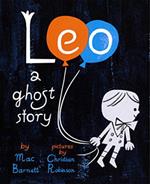 Leo: A Ghost Story is the story of Leo, a young ghost who has been living alone for many years. When a new family takes up residence in his home, it quickly becomes clear that Leo is no longer welcome; he decides to leave his life as a “house ghost” and instead live as a “roaming ghost.” Eventually, after wandering unseen and isolated in the city, he crosses paths with a young girl named Jane, who not only sees Leo, but also quickly befriends him. When Leo discovers that Jane believes he is a figment of her imagination, he worries that revealing himself as a ghost will frighten his new friend away. He decides to stay with Jane, living as her favorite imaginary friend. One evening, a burglar breaks into Jane’s home, but because he cannot be seen, Leo is unable to stop the thief. He covers himself in a bed sheet and apprehends the burglar by locking him in the closet. Stirred from her slumber by the ruckus downstairs, Jane calls the police, who haul the thief off to jail. Jane is puzzled as to how her imaginary friend was able to scare the thief into a closet and Leo reveals that he is, in actuality, a ghost. “That’s even better,” Jane responds enthusiastically; as the narrative ends, the pair go to the kitchen for a midnight snack. Leo: A Ghost Story brings together Mac Barnett’s straightforward, deadpan (pun intended) prose and Christian Robinson’s acrylic paint and cutout construction paper illustrations to create a contemporary picture book with a “timeless” feel.
Leo: A Ghost Story is the story of Leo, a young ghost who has been living alone for many years. When a new family takes up residence in his home, it quickly becomes clear that Leo is no longer welcome; he decides to leave his life as a “house ghost” and instead live as a “roaming ghost.” Eventually, after wandering unseen and isolated in the city, he crosses paths with a young girl named Jane, who not only sees Leo, but also quickly befriends him. When Leo discovers that Jane believes he is a figment of her imagination, he worries that revealing himself as a ghost will frighten his new friend away. He decides to stay with Jane, living as her favorite imaginary friend. One evening, a burglar breaks into Jane’s home, but because he cannot be seen, Leo is unable to stop the thief. He covers himself in a bed sheet and apprehends the burglar by locking him in the closet. Stirred from her slumber by the ruckus downstairs, Jane calls the police, who haul the thief off to jail. Jane is puzzled as to how her imaginary friend was able to scare the thief into a closet and Leo reveals that he is, in actuality, a ghost. “That’s even better,” Jane responds enthusiastically; as the narrative ends, the pair go to the kitchen for a midnight snack. Leo: A Ghost Story brings together Mac Barnett’s straightforward, deadpan (pun intended) prose and Christian Robinson’s acrylic paint and cutout construction paper illustrations to create a contemporary picture book with a “timeless” feel.
Zen Socks. Jon J. Muth. 2015. Scholastic.
 The latest in Jon J. Muth’s Zen series of picture books, Zen Socks is the story of young Leo and Molly and their escapades with their new neighbor, a giant panda named Stillwater. Both through written words and Muth’s watercolor-and-ink illustrations, the text offers various meditations on patience, sharing, kindness, and the often unexpected ways in which we learn new things. Zen Socks is structured as three related vignettes, the first of which focuses on Molly’s dream to be a ballet dancer and emphasizes the importance of both practice and patience. The second vignette draws upon a conversation between Stillwater and Leo to highlight themes of sharing, doing what is right, and rethinking what one may expect will bring happiness. Finally, the third vignette centers on an outing at the beach, where the friends find dozens of starfish trapped on the beach as the tide goes out. Learning that the starfish will dry out in the sun and die, Leo, Molly, and Stillwater begin throwing them one-by-one back into the water. When Leo expresses dismay that there are too many starfish stranded on the sand for them to be able to make a difference, Molly throws another starfish back into the ocean and responds, “It made a difference to him!” Readers will want to remain cognizant of some gender stereotypes embedded in both language and illustrations, but the book offers an accessible consideration of kindness, generosity, and compassion.
The latest in Jon J. Muth’s Zen series of picture books, Zen Socks is the story of young Leo and Molly and their escapades with their new neighbor, a giant panda named Stillwater. Both through written words and Muth’s watercolor-and-ink illustrations, the text offers various meditations on patience, sharing, kindness, and the often unexpected ways in which we learn new things. Zen Socks is structured as three related vignettes, the first of which focuses on Molly’s dream to be a ballet dancer and emphasizes the importance of both practice and patience. The second vignette draws upon a conversation between Stillwater and Leo to highlight themes of sharing, doing what is right, and rethinking what one may expect will bring happiness. Finally, the third vignette centers on an outing at the beach, where the friends find dozens of starfish trapped on the beach as the tide goes out. Learning that the starfish will dry out in the sun and die, Leo, Molly, and Stillwater begin throwing them one-by-one back into the water. When Leo expresses dismay that there are too many starfish stranded on the sand for them to be able to make a difference, Molly throws another starfish back into the ocean and responds, “It made a difference to him!” Readers will want to remain cognizant of some gender stereotypes embedded in both language and illustrations, but the book offers an accessible consideration of kindness, generosity, and compassion.
Ages 9–11
Crenshaw. Katherine Applegate. 2015. Feiwel and Friends.
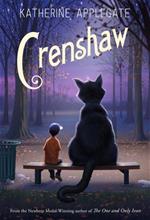 In her first novel since The One and Only Ivan, Newbery Medal–winning author Katherine Applegate returns with Crenshaw, the story of a young boy named Jackson who has never had a mind for make-believe. He values facts more than stories because “You can’t see a story. You can’t hold it in your hand and measure it.” When Jackson realizes that there are few groceries in the house and learns that his family has no money to pay their rent, he inquires as to whether everything is OK. When his parents evade his questions, he understands that his family has again fallen upon hard times. While coming to terms with his family’s circumstances, he is dismayed further when he discovers four purple jelly beans where he should have found cereal; they are a sign that Crenshaw, his imaginary friend from three years earlier, is reemerging. It may seem unlikely for a child as scientific as Jackson to have an imaginary friend (he hopes, after all, to be an “animal scientist” when he grows up), and Crenshaw, too, is unconventional as an imaginary friend. Not only is he a seven-foot-tall cat, he is not overtly supportive of Jackson—at least in the ways one might expect. However, through Crenshaw’s quirks and antics (e.g., his penchant for purple jelly beans, his love of bubble baths and acrobatics), Jackson finds his voice and learns that he is not alone in the world.
In her first novel since The One and Only Ivan, Newbery Medal–winning author Katherine Applegate returns with Crenshaw, the story of a young boy named Jackson who has never had a mind for make-believe. He values facts more than stories because “You can’t see a story. You can’t hold it in your hand and measure it.” When Jackson realizes that there are few groceries in the house and learns that his family has no money to pay their rent, he inquires as to whether everything is OK. When his parents evade his questions, he understands that his family has again fallen upon hard times. While coming to terms with his family’s circumstances, he is dismayed further when he discovers four purple jelly beans where he should have found cereal; they are a sign that Crenshaw, his imaginary friend from three years earlier, is reemerging. It may seem unlikely for a child as scientific as Jackson to have an imaginary friend (he hopes, after all, to be an “animal scientist” when he grows up), and Crenshaw, too, is unconventional as an imaginary friend. Not only is he a seven-foot-tall cat, he is not overtly supportive of Jackson—at least in the ways one might expect. However, through Crenshaw’s quirks and antics (e.g., his penchant for purple jelly beans, his love of bubble baths and acrobatics), Jackson finds his voice and learns that he is not alone in the world.
The Marvels. Brian Selznick. 2015. Scholastic.
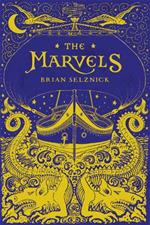 In The Marvels, Brian Selznick continues the genre-defying work he began with The Invention of Hugo Cabret and Wonderstruck. His latest is a volume that exceeds 650 pages, combining both illustration and narrative while building a fictional story off the real lives of two individuals. The first section, spanning approximately 390 pages, opens with the story of Billy Marvel, whose life after a shipwreck leads him to become the first in what will be several generations of celebrated stage actors. Told almost entirely through pencil-and-ink illustrations, the lives of the members of this acting dynasty are traced across two centuries, ending as the theatre in which the family has built their legacy is engulfed in flames. In the second section, the text shifts to approximately 210 pages of written prose before transitioning once again to 40-plus pages of illustrations that bring the novel to a close. Here, the action centers on a 13-year-old boy named Joseph who flees his boarding school to live in England with his reclusive uncle, Albert Nightingale. Albert’s house seemingly belongs in a previous century and is filled with objects and regalia that appear to have once been the property of the Marvel family. Believing that he is somehow connected to the Marvels, Joseph and his friend Frankie begin uncovering clues that reveal a mystery involving Joseph’s family and Albert’s house and that ultimately raises questions about truth and fiction, reality and fantasy, past and present.
In The Marvels, Brian Selznick continues the genre-defying work he began with The Invention of Hugo Cabret and Wonderstruck. His latest is a volume that exceeds 650 pages, combining both illustration and narrative while building a fictional story off the real lives of two individuals. The first section, spanning approximately 390 pages, opens with the story of Billy Marvel, whose life after a shipwreck leads him to become the first in what will be several generations of celebrated stage actors. Told almost entirely through pencil-and-ink illustrations, the lives of the members of this acting dynasty are traced across two centuries, ending as the theatre in which the family has built their legacy is engulfed in flames. In the second section, the text shifts to approximately 210 pages of written prose before transitioning once again to 40-plus pages of illustrations that bring the novel to a close. Here, the action centers on a 13-year-old boy named Joseph who flees his boarding school to live in England with his reclusive uncle, Albert Nightingale. Albert’s house seemingly belongs in a previous century and is filled with objects and regalia that appear to have once been the property of the Marvel family. Believing that he is somehow connected to the Marvels, Joseph and his friend Frankie begin uncovering clues that reveal a mystery involving Joseph’s family and Albert’s house and that ultimately raises questions about truth and fiction, reality and fantasy, past and present.
Ages 12–14
A Curious Tale of the In-Between. Lauren DeStefano. 2015. Bloomsbury.
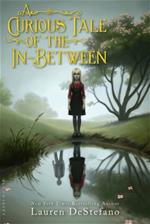 A Curious Tale of the In-Between is mystery/thriller which centers on 11-year-old Pram Bellamy, a young orphan who lives with her aunts, the owners of the “Halfway to Heaven Home for the Ageing.” Since birth, Pram has been able to see two worlds: the world of the living and that of the dead. Her ability to see ghosts has made it difficult for her to make friends and fit in at school, a reality which ultimately suits Pram: She prefers the company of books and her ghost friend, Felix, to the dull individuals that reside in the world of the living. Things begin to change, however, when she meets Clarence, a boy at school who is also motherless. The two quickly bond and decide to go in search of Pram’s father (a sailor who may not know she exists) and the spirit of Clarence’s mother. They align themselves with Lady Savant, a spiritualist who promises to help them but ultimately seeks to use Pram’s abilities for her own ulterior purposes. This suspenseful novel, of particular interest to those intrigued by gothic and paranormal tales, focuses on themes and topics such as death, suicide, the power of friendship, and the importance of family.
A Curious Tale of the In-Between is mystery/thriller which centers on 11-year-old Pram Bellamy, a young orphan who lives with her aunts, the owners of the “Halfway to Heaven Home for the Ageing.” Since birth, Pram has been able to see two worlds: the world of the living and that of the dead. Her ability to see ghosts has made it difficult for her to make friends and fit in at school, a reality which ultimately suits Pram: She prefers the company of books and her ghost friend, Felix, to the dull individuals that reside in the world of the living. Things begin to change, however, when she meets Clarence, a boy at school who is also motherless. The two quickly bond and decide to go in search of Pram’s father (a sailor who may not know she exists) and the spirit of Clarence’s mother. They align themselves with Lady Savant, a spiritualist who promises to help them but ultimately seeks to use Pram’s abilities for her own ulterior purposes. This suspenseful novel, of particular interest to those intrigued by gothic and paranormal tales, focuses on themes and topics such as death, suicide, the power of friendship, and the importance of family.
Serafina and the Black Cloak. Robert Beatty. 2015. Disney/Hyperion.
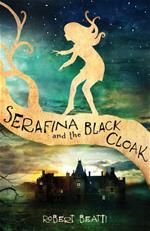 Set in 1899, Serafina and the Black Cloak is the story of 12-year-old Serafina, a young girl who leads an isolated and secretive existence in the immense and opulent Biltmore Estate in Asheville, NC. For as long as she can remember, Serafina has lived in the manor’s basement with her father, a construction worker who stayed on after the estate was built to serve as a repairperson. Although she does not understand his reasoning, Serafina’s father has warned her that she must remain hidden from the home’s residents at all times. Luckily, she possesses unique physical abilities, well-suited to her responsibilities as Chief Rat Catcher, that allow her to move both stealthily and unnoticed throughout the estate. When she witnesses a man in a black cloak abducting a young girl, she begins defying her father’s orders and befriends Braden Vanderbilt, the nephew of the mansion’s owners. As children continue to disappear from the Biltmore Estate, Serafina’s determination to solve the mystery forces beyond the confines of the house itself and into its grounds, where she moves closer to uncovering the identity of the mysterious man in the black cloak and also uncovers the truth about her own identity.
Set in 1899, Serafina and the Black Cloak is the story of 12-year-old Serafina, a young girl who leads an isolated and secretive existence in the immense and opulent Biltmore Estate in Asheville, NC. For as long as she can remember, Serafina has lived in the manor’s basement with her father, a construction worker who stayed on after the estate was built to serve as a repairperson. Although she does not understand his reasoning, Serafina’s father has warned her that she must remain hidden from the home’s residents at all times. Luckily, she possesses unique physical abilities, well-suited to her responsibilities as Chief Rat Catcher, that allow her to move both stealthily and unnoticed throughout the estate. When she witnesses a man in a black cloak abducting a young girl, she begins defying her father’s orders and befriends Braden Vanderbilt, the nephew of the mansion’s owners. As children continue to disappear from the Biltmore Estate, Serafina’s determination to solve the mystery forces beyond the confines of the house itself and into its grounds, where she moves closer to uncovering the identity of the mysterious man in the black cloak and also uncovers the truth about her own identity.
Ages 15+
Feral Pride. Cynthia Leitich Smith. 2015. Candlewick.
 Feral Pride is the third installment in Cynthia Leitich Smith’s Feralseries (which is itself a spin-off of her Tantalize trilogy). Feral Nights, the first in the series, centers on a werecat named Yoshi who goes in search of his sister, Ruby, and discovers that she is a fugitive wanted in connection with the murder of a young werearmadillo. Yoshi, along with a human named Aimee and a werepossum named Clyde, join forces to look for Ruby, and are eventually kidnapped and brought to a dangerous tropical island. As the story continues in Feral Curse, readers are introduced to Kayla, a girl whose boyfriend dies in the midst of a spell conjured to make her a human instead of cat. At the same time, he unintentionally enchants the carousel in a local park and transports shape-shifters of different species (including Yoshi) to Pine Ridge. Feral Pride begins where Feral Curse left off and, like the other titles in the series, is told in multiple voices, with chapters alternating among the perspectives of Clyde, Aimee, Yoshi, and Kayla. As the novel begins, the four characters are driving to Oklahoma in a police cruiser that belongs to Kayla’s friend Jess’s father in an effort to stop an impending war between werepeople and humans. Their journey is interrupted, however, when the governor of Texas is captured by a supernatural creature claiming to be a snake-shifter. Pursued by agents of the federal Humanity Protection unit, the foursome returns to Austin, determined to find a way to stop the yetis, whom they are convinced are responsible for the recent events. With its focus on supernatural creatures and its subplots involving teen romance, the fast-paced and action-packed series could easily lend itself to cinematic or television adaptation.
Feral Pride is the third installment in Cynthia Leitich Smith’s Feralseries (which is itself a spin-off of her Tantalize trilogy). Feral Nights, the first in the series, centers on a werecat named Yoshi who goes in search of his sister, Ruby, and discovers that she is a fugitive wanted in connection with the murder of a young werearmadillo. Yoshi, along with a human named Aimee and a werepossum named Clyde, join forces to look for Ruby, and are eventually kidnapped and brought to a dangerous tropical island. As the story continues in Feral Curse, readers are introduced to Kayla, a girl whose boyfriend dies in the midst of a spell conjured to make her a human instead of cat. At the same time, he unintentionally enchants the carousel in a local park and transports shape-shifters of different species (including Yoshi) to Pine Ridge. Feral Pride begins where Feral Curse left off and, like the other titles in the series, is told in multiple voices, with chapters alternating among the perspectives of Clyde, Aimee, Yoshi, and Kayla. As the novel begins, the four characters are driving to Oklahoma in a police cruiser that belongs to Kayla’s friend Jess’s father in an effort to stop an impending war between werepeople and humans. Their journey is interrupted, however, when the governor of Texas is captured by a supernatural creature claiming to be a snake-shifter. Pursued by agents of the federal Humanity Protection unit, the foursome returns to Austin, determined to find a way to stop the yetis, whom they are convinced are responsible for the recent events. With its focus on supernatural creatures and its subplots involving teen romance, the fast-paced and action-packed series could easily lend itself to cinematic or television adaptation.
Wonders of the Invisible World. Christopher Barzak. 2015. Knopf.
 Seventeen-year-old Aiden Lockwood lives in Temperance, Ohio (a fictionalized, rural town outside Youngstown) on a farm that has been in his family for generations. As the novel opens, Aiden feels detached from his own life, as if he is only going through the motions of a day-to-day existence. Everything changes, however, when his childhood best friend returns to town to finish his senior year of high school. When Aiden first hears Jarrod calling his name in the hallway of their high school, he has no memory of him, nor does he believe they had actually been friends in elementary school. Jarrod reminds Aiden of stories he used to tell about his ability to see things that no one else could, such as a figure dressed in a black suit standing next to their teacher who died the following day. Soon, accompanied by strange dreams, memories that Aiden had forgotten or hidden return to him. As Aiden begins uncovering his family’s secret history, he is charged with the task of freeing his family from an ancestral curse brought upon them by his great-grandfather nearly one century earlier. Although the novel relies on some common tropes in young adult “problem novels” (e.g., Jarrod serves as something of a deus ex machina for Aiden), many readers will look past aspects of the book that feel formulaic and instead focus on the paranormal suspense and the overarching messages about love, family, and the journey toward finding one’s voice and place in the world.
Seventeen-year-old Aiden Lockwood lives in Temperance, Ohio (a fictionalized, rural town outside Youngstown) on a farm that has been in his family for generations. As the novel opens, Aiden feels detached from his own life, as if he is only going through the motions of a day-to-day existence. Everything changes, however, when his childhood best friend returns to town to finish his senior year of high school. When Aiden first hears Jarrod calling his name in the hallway of their high school, he has no memory of him, nor does he believe they had actually been friends in elementary school. Jarrod reminds Aiden of stories he used to tell about his ability to see things that no one else could, such as a figure dressed in a black suit standing next to their teacher who died the following day. Soon, accompanied by strange dreams, memories that Aiden had forgotten or hidden return to him. As Aiden begins uncovering his family’s secret history, he is charged with the task of freeing his family from an ancestral curse brought upon them by his great-grandfather nearly one century earlier. Although the novel relies on some common tropes in young adult “problem novels” (e.g., Jarrod serves as something of a deus ex machina for Aiden), many readers will look past aspects of the book that feel formulaic and instead focus on the paranormal suspense and the overarching messages about love, family, and the journey toward finding one’s voice and place in the world.
Thomas Crisp is an assistant professor in the Department of Early Childhood and Elementary Education, where he teaches courses in children’s and young adult literature and literacy at Georgia State University.
The review contributions are provided by members of the International Literacy Association’s Children’s Literature and Reading Special Interest Group.